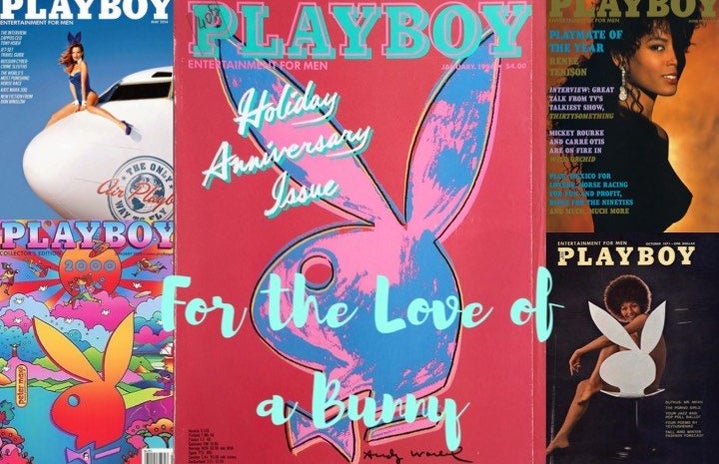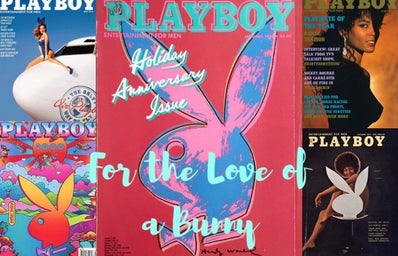Playboy is dodging its own misogynist legacy in one of the most uninventive marketing forays of the last five years.
Playboy can’t seem to come to terms with the fact that it was built on women’s objectification and unconditional sexualization. Playboy can chart its origins back to the days of the 20th century’s “gentlemen’s magazine” (or, as we call it now, dirty magazines). In case you don’t already know, Playboy magazine (the first creation of Playboy Enterprises, the larger brand) was founded by Hugh Hefner, a man unremarkable for anything except for his ability to sell the idea of himself as a womanizer and his magazine as anything the average horny gentleman wanted it to be in the almost 70 years of the publication’s existence.
Playboy is the world’s most popular nudie mag. Over a sprawling seven decades, Playboy has become famous for its lascivious centerfolds and “iconic” covers: the subjects being nude or semi-nude erotic photos of women, famous or otherwise, to varying degrees of artistic ability. However, Playboy can’t keep up with the changing of the tides and the growing notion that women are people and deserve to be represented in media as humans and not objects. Reckoning with this change is something Playboy has been scrambling to do profitably. That’s where the collaborations come in. Allow me to provide some context.
The rise of streetwear couture seems already inherently oxymoronic. Luxury fashion brands quite transparently seek to connect with their younger, more hip, and more diverse clientele by collaborating with (or co-opting) “street” style brands and general iconography. Take, for example, the GuccixSUPERPLASTIC sculpture and NFT capsule collection “SUPERGUCCI.” Or the Louis Vuitton x Nike Air Force 1 exclusive colorways; both of these collaborative projects were released in January of this year. And don’t even get me started on KAWS x literally everything. It’s official; we do, in fact, live in the age of the collab.
The goal of any merchandise collaboration between brands is always to make a profit. Although the fashionably neoliberal retail industry may try to convince us of otherwise, the primary objective of a brand- nay, a company, is to make money. It is not to subvert the fashion economy’s bland hegemonic tastes or be more inclusive. It all comes down to a dollar sign.
Playboy is seeking to cash in on this trend to shift focus away from its weakening ability to seduce its ideal audience/consumer pool via its typical marketing strategies. Overt sexualization of young women by aging men just isn’t in style anymore. The waning allure of Playboy is evident in our current era of fourth-wave feminism and the rejection of the traditional patriarchal standard for a model woman. Thus, Playboy must make use of its iconic “bunny” logo, reinventing it as a symbol of effervescent style and traditionally masculine fashionability rather than the bunny image many of a slightly older generation would find synonymous with the abusive Playboy Mansion, the aggressively unfeminist magazine content, and the personal horror stories of former Playboy Bunnies (i.e., Hugh Hefner’s harem he touted as his live-in “girlfriends”)(see, Down the Rabbit Hole by Holly Madison).
Almost desperately, the Playboy brand is snapping up collabs with any notable streetwear brand out there, including brands such as Missguided that base their image on, ironically, a pro-female empowerment image. We cannot ignore such hypocrisy. Playboy x HUF, Playboy x Pac Sun, Playboy x Tokyo Club and even Playboy x Andy Warhol are all collaborative merch collections available to buy from the official Playboy online store. In a shockingly weird way, Playboy has even attempted to attract the cryptomisogynists by releasing a series of realistic Playboy Bunny NFTs. Playboy has dubbed them the ‘Rabbitars.’
Incredibly, the brand has even created a semi-backstory for the Rabbitars’ universe (?):
Meet the rabbitars
There are many worlds within the metaverse. In this one, known to its inhabitants as Leveretia, a rare species of rabbit known as the Rabbitars are predominant because of their extraordinary speed, cunning, cultural sophistication, razor-sharp wit, and in some cases, sexual prowess.
– playboyrabbitars.com
The Rabbitars of Playboy’s fantasy world Leveretia are a kind of symbol for the image Playboy wants to exude as a company: sophisticated, witty, cunning, and sexually capable. Aside from the mild furry undertones, the Rabbitars sound like a decent marketing strategy. However, the clunkiness of the outdated Playboy promotional model is still visible. Firstly, if anything, an NFT on the blockchain is as far from conducive to building an image of sexual prowess as it gets. Second, Playboy itself has never truly encouraged the women it features to actually take control of their sexuality. Sure, there are girly, feminine appearing Rabbitar NFTs for purchase, but just like with human women, Playboy only truly sees the female as a sexualized tool for profit.
It is not feminist to hide behind lofty brand names in “too cool to miss out on” collabs. The trendiness of a brand collaboration doesn’t negate the complicity with the misogyny of Playboy. Nor is it feminist to make virtual sexy bunny NFTs that are just as (if not less) enabling of misogyny and the sexual dehumanization of women. When the only role Playboy can think of for women is that of objects, items for direct or indirect purchase and consumption, it does no woman favors continuing to tolerate it. Nor is it progressive for Playboy to claim to be feminist, antiracist, and totally woke without acknowledging full-on that the current Playboy brand is unsustainable and irreconcilable with feminism.
Playboy has taken a gamble that the name it has built for itself by being one of the most direct promotors of commercial hypersexuality can remain untarnished as long as it can latch onto a different, more socially acceptable image. Rather than Playboy, the sexy-cool slightly-sexist brand, Playboy seeks to become Playboy the feminist, subversive and empowering brand, all the while continuing to sexualize women in its online and print magazine as well as in the designs of the very fashion and merchandise collabs they are now funneling out.
It’s socially irresponsible to ignore the sloppy stylings of Playboy feminism. Let’s not be the generation that lets Playboy forget the damage it has done. We can do better, as long as we place more value on female empowerment than Playboy x the latest fashion sellout brand.


